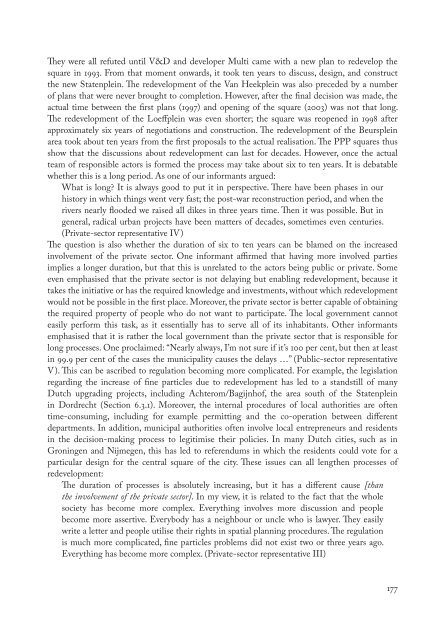Changing public space
Changing public space
Changing public space
Create successful ePaper yourself
Turn your PDF publications into a flip-book with our unique Google optimized e-Paper software.
They were all refuted until V&D and developer Multi came with a new plan to redevelop the<br />
square in 1993. From that moment onwards, it took ten years to discuss, design, and construct<br />
the new Statenplein. The redevelopment of the Van Heekplein was also preceded by a number<br />
of plans that were never brought to completion. However, after the final decision was made, the<br />
actual time between the first plans (1997) and opening of the square (2003) was not that long.<br />
The redevelopment of the Loeffplein was even shorter; the square was reopened in 1998 after<br />
approximately six years of negotiations and construction. The redevelopment of the Beursplein<br />
area took about ten years from the first proposals to the actual realisation. The PPP squares thus<br />
show that the discussions about redevelopment can last for decades. However, once the actual<br />
team of responsible actors is formed the process may take about six to ten years. It is debatable<br />
whether this is a long period. As one of our informants argued:<br />
What is long? It is always good to put it in perspective. There have been phases in our<br />
history in which things went very fast; the post-war reconstruction period, and when the<br />
rivers nearly flooded we raised all dikes in three years time. Then it was possible. But in<br />
general, radical urban projects have been matters of decades, sometimes even centuries.<br />
(Private-sector representative IV)<br />
The question is also whether the duration of six to ten years can be blamed on the increased<br />
involvement of the private sector. One informant affirmed that having more involved parties<br />
implies a longer duration, but that this is unrelated to the actors being <strong>public</strong> or private. Some<br />
even emphasised that the private sector is not delaying but enabling redevelopment, because it<br />
takes the initiative or has the required knowledge and investments, without which redevelopment<br />
would not be possible in the first place. Moreover, the private sector is better capable of obtaining<br />
the required property of people who do not want to participate. The local government cannot<br />
easily perform this task, as it essentially has to serve all of its inhabitants. Other informants<br />
emphasised that it is rather the local government than the private sector that is responsible for<br />
long processes. One proclaimed: “Nearly always, I’m not sure if it’s 100 per cent, but then at least<br />
in 99.9 per cent of the cases the municipality causes the delays …” (Public-sector representative<br />
V). This can be ascribed to regulation becoming more complicated. For example, the legislation<br />
regarding the increase of fine particles due to redevelopment has led to a standstill of many<br />
Dutch upgrading projects, including Achterom/Bagijnhof, the area south of the Statenplein<br />
in Dordrecht (Section 6.3.1). Moreover, the internal procedures of local authorities are often<br />
time-consuming, including for example permitting and the co-operation between different<br />
departments. In addition, municipal authorities often involve local entrepreneurs and residents<br />
in the decision-making process to legitimise their policies. In many Dutch cities, such as in<br />
Groningen and Nijmegen, this has led to referendums in which the residents could vote for a<br />
particular design for the central square of the city. These issues can all lengthen processes of<br />
redevelopment:<br />
The duration of processes is absolutely increasing, but it has a different cause [than<br />
the involvement of the private sector]. In my view, it is related to the fact that the whole<br />
society has become more complex. Everything involves more discussion and people<br />
become more assertive. Everybody has a neighbour or uncle who is lawyer. They easily<br />
write a letter and people utilise their rights in spatial planning procedures. The regulation<br />
is much more complicated, fine particles problems did not exist two or three years ago.<br />
Everything has become more complex. (Private-sector representative III)<br />
177




